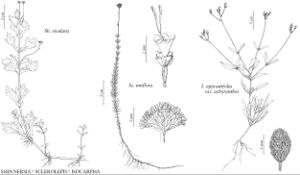Sclerolepis uniflora
Prelim. Cat., 25. 1888.
Plants usually creeping and mat-forming; rhizomes relatively slender. Stems: submersed flexuous, to 60 cm; emersed ± ascending, 10–30 (–45) cm. Leaf-blades 7–23 × 0.3–2 mm. Peduncles 2–6 cm. Phyllaries 2–4 mm, margins minutely serrulate, faces glabrous. Corollas 2–3 mm (style-branches conspicuously exserted). Cypselae 2–3.5 mm; pappi: scales indurate, broadly oblong, margins crenulate, apices obtuse, erose. 2n = 30.
Phenology: Flowering summer–fall.
Habitat: In still water, sandy or peaty shorelines of ponds, bogs, swamps, wet flatwoods, low savannas, wet depressions, ditches
Elevation: 0–100+ m
Distribution

Ala., Del., Fla., Ga., Md., Mass., N.H., N.J., N.C., R.I., S.C., Va.
Discussion
Sclerolepis uniflora is uncommon north of North Carolina, being restricted to the Delmarva Peninsula in Delaware, Maryland, and Virginia; in New Jersey it occurs in the southern part of the pine barrens and in Cape May County. Two populations of S. uniflora are known in New England: one in southern New Hampshire, the other on the Massachusetts-Rhode Island state border.
The submersed, aquatic growth form of Sclerolepis uniflora has been rarely reported or collected. The submersed form is entirely vegetative; the stems are longer and the leaves more flaccid, elongated, and loosely arranged than in emergent plants. As water levels drop, the horizontal stems become anchored in exposed substrates and develop upright shoots of the terrestrial form, producing solitary, terminal heads of flowers.
Selected References
None.
Lower Taxa
"fine" is not a number.
